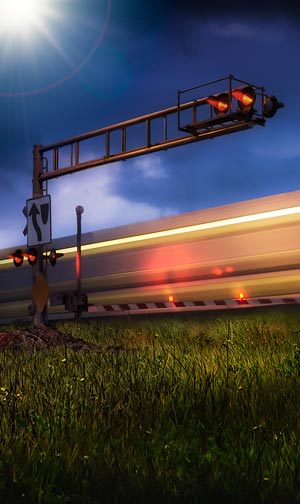Midland Crossing Tragedy Crossing Signals Get Extended Buffer Time by Union Pacific
(Midland, Texas – December 21, 2012)
Possibly in an attempt to more accurately and appropriately align flashing lights and gates to their originally designed and approved operational timing at the site of the horrible November 15 tragedy when a Union Pacific freight train struck a flatbed semi-trailer truck being used as a parade float in the annual Midland, TX “Show of Support/Hunt For Heroes” celebration honoring wounded American veterans, UPRR signal crews were at the Garfield Street crossing Friday, adjusting the signal circuits to “improve buffer time” between the activation of the crossing protective devices and the arrival of trains at the crossing.
After the accident, which took the lives of four wounded veterans and injured 16 more participants and spouses, tests by both the National Transportation Safety Board and team of attorneys representing some of the veterans and their wives showed the signals to be marginally compliant with federal regulations, but not with Texas Dept. of Transportation documents which originally authorized installation of the signal protective system in use at the crossing.
In an e-mailed statement to the news media, Union Pacific Spokeswoman Raquel Espinoza said the “improved buffer time” would put warning time at the Midland crossing to “over and above” the minimum warning time required by federal regulations.
In a carefully-worded statement, the UPRR spokeswoman said that “The buffer time is added to further ensure that the signal system always provides the warning time required by federal regulations – as it did the day of the accident.”
Documentation of the original approved signal design and installation provided by TxDOT Rail Division official Darin Kosmack showed that the signals were supposed to give motorists 30 seconds of warning from activation of the flashing signals, dropping of the gates and arrival of a train at the Garfield Street crossing rather than the bare minimum 20 seconds, and that no record of approval of any adjustment of the timing was ever filed.
According to Manhattan, KS-based attorney Bob Pottroff, who is teaming with Lubbock, TX attorney Kevin Glasheen to represent several of the victims and their spouses, Union Pacific’s statement does not address the essential fact that the crossing protective devices should have given at least a 30-second warning. “It continually gives 20 seconds (of warning), and that’s a failure (of the system as designed and approved),” asserted Pottroff.
The plaintiffs’ attorney further explained to the news media that video cameras set up at the scene of the tragedy by his team following the accident showed that eastbound trains (as was the UPRR freight train involved in the collision) give 20 seconds of warning, while westbound trains give nearly 40 seconds. “That means there’s a circuitry issue that needs to be corrected,” he said .The suit filed on behalf of the injured veterans and their spouses charges that Union Pacific failed to provide the reasonable and timely audible and visual warning of the approaching train and failed to provide a safe railroad crossing. In addition, it says that the train did not activate its brakes or otherwise attempt to slow, and that the railroad had not fixed what the suit says are hazardous conditions posed by the road’s grade.


